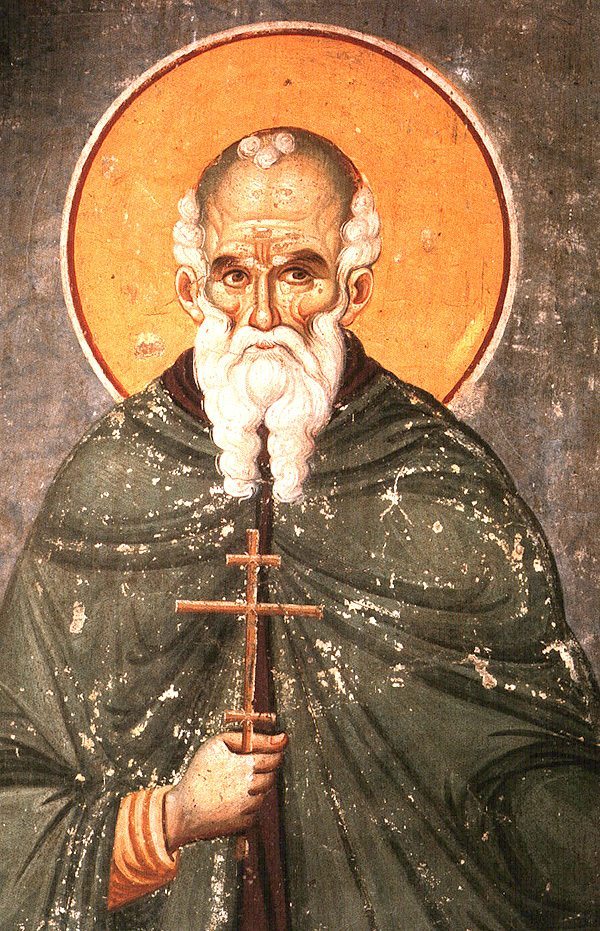Saint Athanase l'Athonite
Fondateur de la Lavra au mont Athos (✝ v. 1004)
Abramios naît à Trébizonde, sur les bords de la Mer Noire, dans une famille de la haute aristocratie byzantine. Pour parfaire ses études, il se rend à Constantinople où il obtient un poste de professeur. Vient à passer par la capitale, saint Michel Maleïnos, higoumène d'un monastère de Bithynie. La rencontre du saint moine détermine la vocation du professeur Abramios qui repart en Bithynie avec Michel. Il reçoit le nom monastique d'Athanase et se lie d'amitié avec le neveu de Michel, Nicéphore Phocas, futur empereur byzantin. Au bout de quelques années, Athanase disparaît. On le retrouve, ermite incognito, sur le Mont Athos, cherchant la vie parfaite dans des cabanes de branchages. Athanase voulait rester seul avec le Seul. Mais le Seul et l'empereur byzantin en avaient décidé autrement. Le soutien impérial lui donne les moyens nécessaires pour fonder le grand monastère de Lavra sur la Sainte Montagne, puis d'autres monastères, malgré l'opposition des ermites pour qui la vie commune est une forme abâtardie du monachisme. Dans ces fondations de monastères, l'ami de l'empereur met la main à la pâte et se fait maçon, menuisier, charpentier. Il mourra écrasé par la coupole d'une église à laquelle il travaillait.
Au Mont Athos, vers 1004, saint Athanase, supérieur humble et pacifique, qui établit dans la Grande Laure la vie cénobitique, avec des cellules au voisinage de l’église.
Martyrologe romain
ATHANASE L'ATHONITE (entre 925 et 930-1002)
Abraamios, le futur Athanase, naît à Trébizonde, où, orphelin, il grandit, épris de vie intérieure, dans la meilleure société. Après 945, il fait à Constantinople une brillante carrière universitaire, mais rompt avec le siècle après avoir rencontré un grand spirituel, Michel Maléïnos, higoumène du mont Kymina, où Abraamios devient moine sous le nom d'Athanase (vers 952). Hésychaste accompli, il craint pour sa solitude devant l'afflux des moines et, vers 958, fuit à l'Athos où ne vivent alors que des ermites. Il entretient une amitié difficile avec le grand chef de guerre Nicéphore Phocas qui est un disciple laïc de Maléïnos et qui, ne pouvant arracher durablement Athanase à l'Athos, lui demande d'y construire une « laure » où lui-même compte se retirer. La Grande Laure (Lavra) s'élève ainsi de 961 à 963, destinée, semble-t-il, à favoriser une vie semi-érémitique. Mais, après l'accession à l'empire et l'assassinat de Nicéphore, Athanase, bouleversé, se rallie définitivement au cénobitisme : Lavra devient la première communauté de l'Athos, à laquelle d'autres s'ajoutent du vivant même d'Athanase, constituant la forte structure du monachismeathonite. Athanase meurt accidentellement en 1002, dans un effondrement, alors qu'il visite les travaux du catholicon.
Les règles (hypotypose et typicon), écrites par Athanase pour sa communauté, reprennent et accentuent dans le sens de l'ordre et de la régularité les dispositions du Stoudios. La journée du moine est partagée entre l'office, la lecture et le travail manuel ; l'idéal proposé est de fraternité évangélique, dans la soumission mutuelle (hypotagé). Toutefois, par rapport à la règle stoudite, l'insistance se déplace de l'hypotagéà l'obéissance au supérieur (hypakoé), où l'on trouve peut-être une réminiscence de la règle bénédictine. Athanase, d'autre part, a prévu que quelques moines pourraient vivre en hésychastes. Ainsi se fera, non sans tension, la synthèse athonite de l'érémitisme et du cénobitisme, avec un large éventail de vocations.
Olivier CLÉMENT, « ATHANASE L'ATHONITE (entre 925 et 930-1002) », Encyclopædia Universalis [en ligne], consulté le 5 juillet 2015. URL : http://www.universalis.fr/encyclopedie/athanase-l-athonite/
Athanasius the Athonite, Abbot (AC)
Born at Trebizond c. 920; died c. 1003. Son of an Antiochene and baptized Abraham, Athanasius studied at Constantinople. He was successful in his studies and a safe career in the civil service was his for the asking. But instead he became a monk at Saint Michael's monastery at Kymina, Bithynia. This was a laura, i.e., a group of monasteries where the monks lived individual lives around their church.
To avoid being named abbot of Saint Michael's when the abbot, Saint Michael Maleinos, died, Athanasius hid in a cell at Karyes, changed his name, and pretended to be illiterate. He migrated to Mount Athos in Greece. Mount Athos, one of the three peaks on the Chalcedonian Peninsula which juts out into the Aegean Sea, is one of the most exquisitely lovely places in the world. It is a land of red and ocher and gold, of cypresses and begonias and bougainvilleas, of fantastic roofs and brilliant sunlight, of sparkling sea and arid mountain.
Saint Athanasius was not the first holy man to live on Mount Athos, for since the 9th century anchorites, such as Peter the Athonite and Euthymius the Thessalonian, had lived in caves among the rocks.
When he reached Mount Athos in 958, an old friend from Constantinople, Nicephorus Phocas, asked his help in preparing an expedition against the Saracens in 961. Phocas insisted on appointing him almoner of his fleet.
On its successful completion, Athanasius returned to Mount Athos and with money given him by a grateful Phocas began the first monastery on Athos in 961. Athanasius wanted to found a new kind of monastery, the so-called idiorhythmic monastery, where each inmate could follow his own rhythm and tempo. His hope was that anchorites, hermits, wandering monks, and cenobites could all live together in his laura.
When Nicephorus Phocas became emperor in 963, the year the monastery was dedicated, Athanasius fled to Cyprus to avoid being called to court, but the emperor found him, reassured him, and gave him money to continue his work on Athos.
Athanasius encountered great opposition from hermits living on the mountain long before he had arrived there as he attempted to install the laura system there. He escaped two murder attempts, and resistance ended only when Emperor John Tzimisces forbade any opposition to Athanasius.
In time he became superior over 58 communities of monks and hermits on the mount. Thousands of monks still live and pray there today in 20 monasteries; it is now and has been for centuries the center of Eastern Orthodox monasticism and not in communion with Rome since shortly after the saint's death. The monastery that Athanasius founded is still the largest.
Though celibate--indeed every woman, every female animal and every smooth-faced creature is banned--they are not held to fasting or abstinence. They are obliged to obey an abbot, but they do not have to attend services except on major feast days. They provide their own food and are not bound to poverty, and in fact many of them keep their personal wealth.
It might perhaps sound as if they are indulgent to themselves and giving themselves too much personal freedom. But, in fact, the system confers heightened value on their virtuous acts, because they are done freely, and not out of constraint of obedience.
The idiorhythmic rule that Athanasius established was far in advance of his times--a radical departure from the customs of other monasteries. He made his monastery as little like a barracks as possible. He did, however, force his monks to read and study the Bible and one of his first concerns was to open a school next to the monastery.
Throughout his life he despised worldly honors as greatly as he despised ignorance. He had a particular contempt for gluttony, even going so far as to excommunicate those monks he found guilty of it. Since his day his monks have lived an independent existence, taking gifts from no one and providing their own simple needs themselves.
His memory is preserved not only in the rule that he established and the buildings that he erected but also in the hundreds of trees that he planted in the courtyards and on the terraces, in the imposing library he founded, and in the reliquaries of Nicephorus Phocas, whom he had served.
A Catholic one was being added to the monastery, a church in the form of a Greek cross where the "nikterinos" or night office was to be recited. Athanasius, who was supervising the work, and five of his monks were killed when the arch of a church on which they were working collapsed (Attwater, Benedictines, Delaney, Encyclopedia).
An anonymous Russian icon of Athanasius with Saints Barlaam and Joasaph is available on the web.













